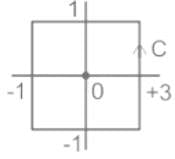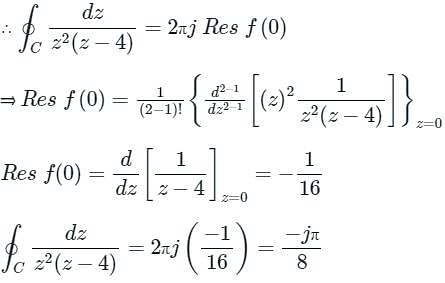Civil Engineering (CE) Exam > Civil Engineering (CE) Questions > Let (-1 - j), (3 - j), (3 + j) and (-1 + j) b...
Start Learning for Free
Let (-1 - j), (3 - j), (3 + j) and (-1 + j) be the vertices of a rectangle C in the complex plane. Assuming that C is traversed in counter-clockwise direction, the value of the countour integral  is
is
 is
is- a)0
- b)jπ/16
- c)jπ/2
- d)-jπ/8
Correct answer is option 'D'. Can you explain this answer?
Verified Answer
Let (-1 - j), (3 - j), (3 + j) and (-1 + j) be the vertices of a recta...
Concept:
Residue Theorem:
If f(z) is analytic in a closed curve C except at a finite number of singular points within C, then
∫cf(z) dz = 2πj × [sum of residues at the singular points within C]
Formula to find residue:
1. If f(z) has a simple pole at z = a, then

2. If f(z) has a pole of order n at z = a, then

Application:
Given (-1 - j), (3 - j), (3 + j) and (-1 + j) are the vertices of a rectangle C in the complex plane

f(z) from the given data is,


2. If f(z) has a pole of order n at z = a, then

Application:
Given (-1 - j), (3 - j), (3 + j) and (-1 + j) are the vertices of a rectangle C in the complex plane

f(z) from the given data is,

Poleas of f(z) is
z = 0 of order n = 2, lies in side the closed curve.
z = 4 of order n = 1, lies outside the closed curve.


Most Upvoted Answer
Let (-1 - j), (3 - j), (3 + j) and (-1 + j) be the vertices of a recta...
Concept:
Residue Theorem:
If f(z) is analytic in a closed curve C except at a finite number of singular points within C, then
∫cf(z) dz = 2πj × [sum of residues at the singular points within C]
Formula to find residue:
1. If f(z) has a simple pole at z = a, then

2. If f(z) has a pole of order n at z = a, then

Application:
Given (-1 - j), (3 - j), (3 + j) and (-1 + j) are the vertices of a rectangle C in the complex plane

f(z) from the given data is,


2. If f(z) has a pole of order n at z = a, then

Application:
Given (-1 - j), (3 - j), (3 + j) and (-1 + j) are the vertices of a rectangle C in the complex plane

f(z) from the given data is,

Poleas of f(z) is
z = 0 of order n = 2, lies in side the closed curve.
z = 4 of order n = 1, lies outside the closed curve.



|
Explore Courses for Civil Engineering (CE) exam
|

|
Let (-1 - j), (3 - j), (3 + j) and (-1 + j) be the vertices of a rectangle C in the complex plane. Assuming that C is traversed in counter-clockwise direction, the value of the countour integralisa)0b)jπ/16c)jπ/2d)-jπ/8Correct answer is option 'D'. Can you explain this answer?
Question Description
Let (-1 - j), (3 - j), (3 + j) and (-1 + j) be the vertices of a rectangle C in the complex plane. Assuming that C is traversed in counter-clockwise direction, the value of the countour integralisa)0b)jπ/16c)jπ/2d)-jπ/8Correct answer is option 'D'. Can you explain this answer? for Civil Engineering (CE) 2025 is part of Civil Engineering (CE) preparation. The Question and answers have been prepared according to the Civil Engineering (CE) exam syllabus. Information about Let (-1 - j), (3 - j), (3 + j) and (-1 + j) be the vertices of a rectangle C in the complex plane. Assuming that C is traversed in counter-clockwise direction, the value of the countour integralisa)0b)jπ/16c)jπ/2d)-jπ/8Correct answer is option 'D'. Can you explain this answer? covers all topics & solutions for Civil Engineering (CE) 2025 Exam. Find important definitions, questions, meanings, examples, exercises and tests below for Let (-1 - j), (3 - j), (3 + j) and (-1 + j) be the vertices of a rectangle C in the complex plane. Assuming that C is traversed in counter-clockwise direction, the value of the countour integralisa)0b)jπ/16c)jπ/2d)-jπ/8Correct answer is option 'D'. Can you explain this answer?.
Let (-1 - j), (3 - j), (3 + j) and (-1 + j) be the vertices of a rectangle C in the complex plane. Assuming that C is traversed in counter-clockwise direction, the value of the countour integralisa)0b)jπ/16c)jπ/2d)-jπ/8Correct answer is option 'D'. Can you explain this answer? for Civil Engineering (CE) 2025 is part of Civil Engineering (CE) preparation. The Question and answers have been prepared according to the Civil Engineering (CE) exam syllabus. Information about Let (-1 - j), (3 - j), (3 + j) and (-1 + j) be the vertices of a rectangle C in the complex plane. Assuming that C is traversed in counter-clockwise direction, the value of the countour integralisa)0b)jπ/16c)jπ/2d)-jπ/8Correct answer is option 'D'. Can you explain this answer? covers all topics & solutions for Civil Engineering (CE) 2025 Exam. Find important definitions, questions, meanings, examples, exercises and tests below for Let (-1 - j), (3 - j), (3 + j) and (-1 + j) be the vertices of a rectangle C in the complex plane. Assuming that C is traversed in counter-clockwise direction, the value of the countour integralisa)0b)jπ/16c)jπ/2d)-jπ/8Correct answer is option 'D'. Can you explain this answer?.
Solutions for Let (-1 - j), (3 - j), (3 + j) and (-1 + j) be the vertices of a rectangle C in the complex plane. Assuming that C is traversed in counter-clockwise direction, the value of the countour integralisa)0b)jπ/16c)jπ/2d)-jπ/8Correct answer is option 'D'. Can you explain this answer? in English & in Hindi are available as part of our courses for Civil Engineering (CE).
Download more important topics, notes, lectures and mock test series for Civil Engineering (CE) Exam by signing up for free.
Here you can find the meaning of Let (-1 - j), (3 - j), (3 + j) and (-1 + j) be the vertices of a rectangle C in the complex plane. Assuming that C is traversed in counter-clockwise direction, the value of the countour integralisa)0b)jπ/16c)jπ/2d)-jπ/8Correct answer is option 'D'. Can you explain this answer? defined & explained in the simplest way possible. Besides giving the explanation of
Let (-1 - j), (3 - j), (3 + j) and (-1 + j) be the vertices of a rectangle C in the complex plane. Assuming that C is traversed in counter-clockwise direction, the value of the countour integralisa)0b)jπ/16c)jπ/2d)-jπ/8Correct answer is option 'D'. Can you explain this answer?, a detailed solution for Let (-1 - j), (3 - j), (3 + j) and (-1 + j) be the vertices of a rectangle C in the complex plane. Assuming that C is traversed in counter-clockwise direction, the value of the countour integralisa)0b)jπ/16c)jπ/2d)-jπ/8Correct answer is option 'D'. Can you explain this answer? has been provided alongside types of Let (-1 - j), (3 - j), (3 + j) and (-1 + j) be the vertices of a rectangle C in the complex plane. Assuming that C is traversed in counter-clockwise direction, the value of the countour integralisa)0b)jπ/16c)jπ/2d)-jπ/8Correct answer is option 'D'. Can you explain this answer? theory, EduRev gives you an
ample number of questions to practice Let (-1 - j), (3 - j), (3 + j) and (-1 + j) be the vertices of a rectangle C in the complex plane. Assuming that C is traversed in counter-clockwise direction, the value of the countour integralisa)0b)jπ/16c)jπ/2d)-jπ/8Correct answer is option 'D'. Can you explain this answer? tests, examples and also practice Civil Engineering (CE) tests.

|
Explore Courses for Civil Engineering (CE) exam
|

|
Signup for Free!
Signup to see your scores go up within 7 days! Learn & Practice with 1000+ FREE Notes, Videos & Tests.






















